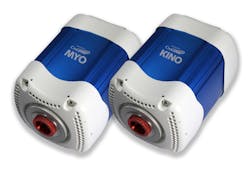Designer and manufacturer of cameras for the life sciences, Photometrics (Tucson, AZ), has introduced the CoolSNAP MYO and the CoolSNAP KINO CCD cameras. Designed to discern finer details in biological samples under lower light levels, both cameras enable scientists to achieve higher quality, higher resolution images than previous CCD technology. The MYO is capable of cooling to 0°C and features a fan that can be disabled to provide flexibility to optimize cooling for longer exposures in low-light scenarios and still accommodate vibration-sensitive measurements. The KINO is cooled to 20°C without a fan, making it suitable for sensitive applications such as AFM where vibration is not tolerated. Both models are ideal for immunofluorescence and fluorescent protein imaging.
-----
PRESS RELEASE
Photometrics® Launches Next Generation Scientific CCD Cameras That Enable Scientists to Discern Finer Details of Dimmer Samples Under Lower Light Levels
TUCSON, Ariz.-- Photometrics introduces the CoolSNAP™ MYO and the CoolSNAP™ KINO CCD cameras, the newest members of the popular CoolSNAP camera line. Designed to discern finer details in biological samples under lower light levels, the MYO and KINO enable scientists to achieve higher quality, higher resolution images than previous CCD technology.
“The CoolSNAP MYO and KINO cameras are a stepped change in superior spatial resolution and higher quantum efficiency, making better science possible”
With standard scientific CCD sensor technology, researchers are currently limited to 1.4 megapixel imaging with 65% quantum efficiency. Packing twice as many pixels (2.8M) with a 15% improvement in peak quantum efficiency (75%), the MYO and KINO offer scientists the ability to visualize much finer details at much higher sensitivity. Photometrics is the first and only camera company to offer this new sensor technology.
The MYO is capable of cooling to 0°C and features a fan that can be disabled, which provides flexibility to optimize cooling for longer exposures in low-light scenarios and still accommodate extremely vibration-sensitive measurements. The KINO is cooled to 20°C without a fan, making it suitable for sensitive applications such as AFM where vibration is not tolerated. The MYO and KINO are ideal camera technologies for immunofluorescence and fluorescent protein imaging. The cameras are also well suited for near infrared DIC, electrophysiology, particle tracking, FRET and FRAP imaging.
The CoolSNAP MYO and KINO cameras share the following additional features:
- 4.54 µm pixel pitch
- 6.2 frames per second
- USB 2.0 interface
“The CoolSNAP MYO and KINO cameras are a stepped change in superior spatial resolution and higher quantum efficiency, making better science possible,” said Rachit Mohindra, Photometrics product manager.
The CoolSNAP MYO and KINO are the next generation advancement of the CoolSNAP™ ES2 and CoolSNAP™ EZ cameras.
About Photometrics
Photometrics designs and manufactures high-performance CCD cameras and EMCCD cameras for life science research. The original architect of the world’s first scientific-grade microscopy EMCCD camera, the company has achieved multiple awards and earned its leadership role with several decades of strong product design and delivery. Tens of thousands of researchers around the globe rely on these imaging solutions to support their most demanding quantitative bio-research applications. Photometrics also offers a comprehensive OEM camera program. Founded in 1978 Photometrics is headquartered in Tucson, Arizona in the US and is a registered ISO 9001:2008 company. Additional information is available at www.photometrics.com.
